How to Enter and Exit Full Screen Mode and Use Split Screen in macOS
Posted on
by
Kirk McElhearn
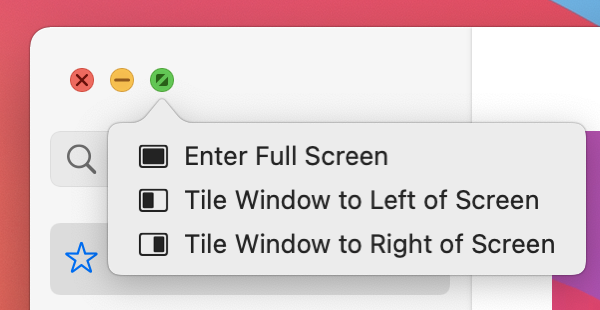
The size of your Mac’s display can affect the way you work. If you have a capacious 27-inch iMac, you’ve got lots of room to stretch out. You can have several windows visible, large and small, each organized efficiently. On the contrary, if you have a smaller Mac, like a 12-inch MacBook, there’s not much room for multiple windows, and you may want to make each one as large as possible. Fortunately, macOS offers a "full-screen mode," which you can use for most of your apps.
When you’ve got limited screen space available, it’s a good idea to use every pixel of it. By default, macOS displays the Dock at the bottom of the screen, and it’s always visible. When you open an app, its window only stretches from the top of the display to the top of the Dock, so you’re missing out on some valuable space.
In an article about getting to know your Mac’s Dock, I explained how you can either position the Dock to the left of the display—getting more vertical space at the expense of slightly less horizontal space—or hide it entirely.
In this article, I’m going to discuss how you use full-screen mode in macOS, and how you can get the most out of this feature to work efficiently on a small display.
How do you make a window full screen on a Mac?
To make your windows as large as possible, you can use full-screen mode. Even if the Dock is visible, switching an app into full-screen mode makes its window fill your display from top to bottom, and from left to right. The Dock is hidden; to access it, move your cursor to the bottom or the side of the screen, where the Dock is, and it slides into view.
It’s quite simple to activate full-screen mode for any app on a Mac, and there are three ways you can do this:
- Click the green button at the left of its toolbar,
- Press Command-Control-F, or
- Choose View > Enter Full Screen.
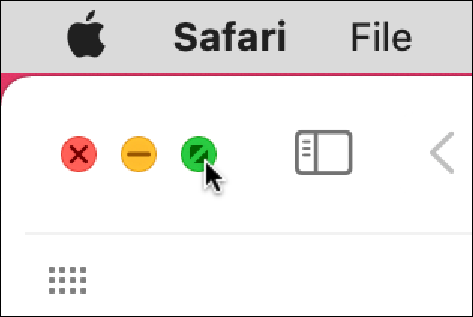
You’ll see the window expand, your menu bar slide away, and the Dock slide off the screen (if it’s visible). This window now fills the screen.
(Note that some windows can’t display full screen; if their size is fixed, then you won’t see the green button. You can see this in the System Preferences app, for example, and in preferences or settings windows of apps.)
While your apps fill the screen, you can still access the menu bar; just move your cursor to the top of the display and it slides down so you can access menus.
Another way to fill the screen is to press the Option key and then click the green button. This expands the window to take up as much space as possible, while not hiding the menu bar and Dock. This is not the same as full-screen mode, but it takes advantage of as much of your display as possible while still allowing you to see the menu bar and (if it’s not hidden) the Dock.
How to exit full screen mode on macOS
When you want to leave full-screen mode, move your cursor to the top of your display to show your app’s toolbar or title bar and click the green button. Another way you can exit full screen mode is to press Command-Control-F, or choose View > Exit Full Screen.
How to switch apps in full screen mode
When you’re in full-screen mode, you may need to change the way you switch apps. If you’re used to clicking icons in the Dock or clicking parts of windows to switch from one app to another, it’s time to learn some new techniques. Here’s how you can switch apps in full-screen mode:
- Use the Application Switcher. Press Command-Tab and keep pressing Tab until you find the icon for the app you want to switch to, then release both keys.
- Swipe left or right with four fingers on a trackpad or Magic Mouse. Admittedly, this isn’t easy on a mouse, and four fingers may be a bit of a constraint even on a trackpad. If you go to System Preferences > Trackpad > More Gestures, you can change this to a three-finger swipe.
- Press the Control key, then press the right-arrow key or left-arrow key to move back and forth among full-screen apps.
- Press the Mission Control key (the F3 key) on an Apple keyboard, move your cursor to the top of the screen, then click one of the app thumbnails at the top of the display.
Here’s what Mission Control looks like with three full-screen apps. Note the icon at the top left corner of the App Store window; click that to restore it to a standard window.
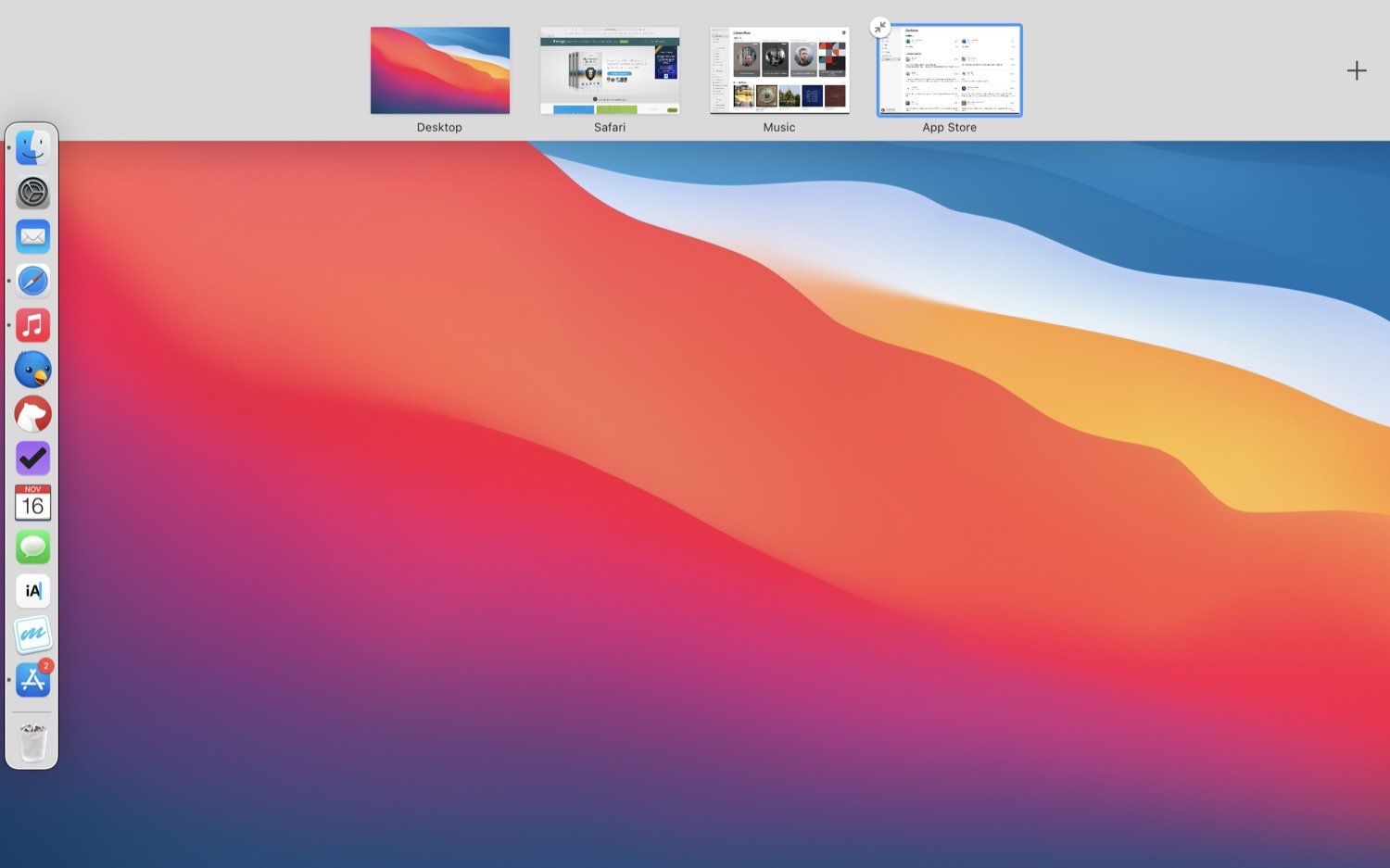
How to use the Mac’s split-screen mode
In addition to offering a full-screen mode, macOS also allows you to set up apps in split screen mode. If you move your cursor over the green button, you’ll seen a pop-up menu with several options. You can Enter Full Screen, or you can tile the window to the right or left of the screen. (And if you have an iPad capable of using Sidecar, you’ll seen an option to move a window to that iPad. See this article for more on using Sidecar.)
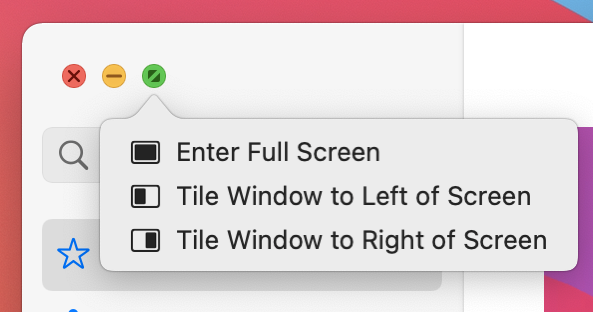
Split-screen mode is a sort of full-screen mode with a bonus. When you send one app to one side of your display, the screen splits with a divider. You can then open a second app on the other side. To do this, click a window in the other side. Here’s what it looks like to have two windows in split-screen mode; I’ve opened Safari and Chrome in two panes.
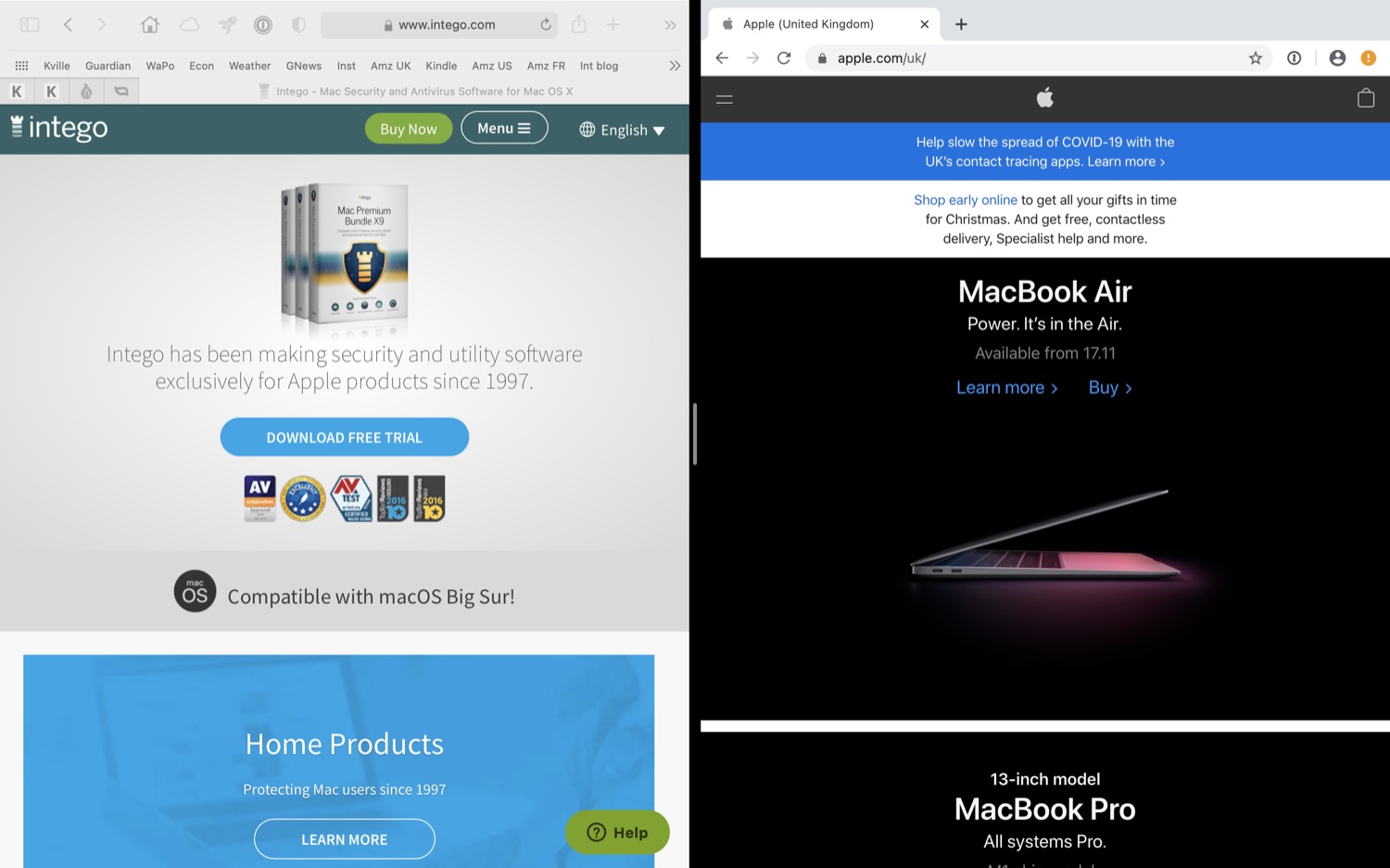
You can drag the divider to adjust how the two windows share the screen, but some windows don’t allow much adjustment. And there are some apps that you cannot use in split-screen view, because they either have widows that are fixed sizes (such as System Preferences), or they are not designed for the narrower view (such as the Music app).
As with full-screen view, you can exit split screen view for any app by pressing Command-Control-F.
Why go full-screen mode on a Mac?
The Mac has long had a multi-window interface. This is practical if, say, you’re researching something in Safari and writing a paper or report in another app. Or if you’re working in Photoshop editing a number of graphics in a folder visible in the Finder. It’s easier to have both windows visible—if you have the space—rather than switching back and forth from one to the other.
That said, on a smaller display you might not have enough room for two windows to be easy to access. Rather than feel cramped, you can use all of your display for each app.
You also have fewer distractions if you have a single app filling your display. As I write this article, for example, Mail is partly visible behind my text editor, and if I get new emails, I see them show up in my inbox. Conversely, I might have a page open in Safari that I don’t need to see when I’m working on a spreadsheet, and be distracted by graphics or ads. Using full-screen mode removes all those extraneous items.
When should you use full-screen mode?
As you’ve seen above, full-screen mode is useful if you have a small display. Even on a larger desktop Mac, it can be practical because you may want to eliminate distractions when you’re working. And if you’re used to working on an iPad, where full-screen mode is the norm, you may find that doing the same on your Mac is comfortable.
If you’re a writer, you’ll find apps that have a more subtle full-screen mode than simply filling a window. For example, Scrivener has a Composition Mode, which fills the screen, but lets you control the width of the text, colors, and more. It’s the ideal way to write without distraction.
If you’re viewing a PDF with Preview, full-screen mode lets you easily view two pages side by side. And if you’re watching a video on your Mac, then full-screen is the best way to do so.
One scenario in which you probably don’t want to view a web browser in full-screen mode is when you’re using a large display. This is simply because most webpages might look odd, with content either centered between huge margins or with text running the full width of the display.
Try out different apps and see which are easier to use in full-screen mode. You may discover a new way of working with your favorite apps!
How can I learn more?
 Each week on the Intego Mac Podcast, Intego’s Mac security experts discuss the latest Apple news, security and privacy stories, and offer practical advice on getting the most out of your Apple devices. Be sure to follow the podcast to make sure you don’t miss any episodes.
Each week on the Intego Mac Podcast, Intego’s Mac security experts discuss the latest Apple news, security and privacy stories, and offer practical advice on getting the most out of your Apple devices. Be sure to follow the podcast to make sure you don’t miss any episodes.
You can also subscribe to our e-mail newsletter and keep an eye here on Mac Security Blog for the latest Apple security and privacy news. And don’t forget to follow Intego on your favorite social media channels: Facebook, Instagram, Twitter, and YouTube.